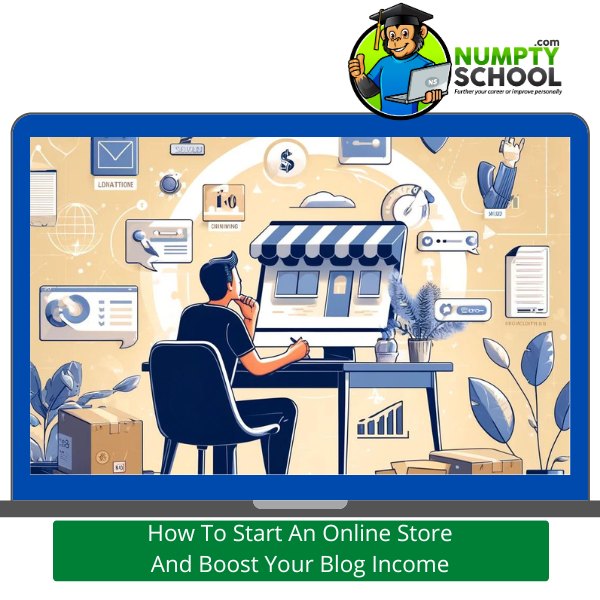How To Start An Online Store And Boost Your Blog Income
Introduction to Starting an Online Store
What is an Online Store?
An online store, also known as an e-commerce store, is a digital platform where businesses sell products or services over the internet. It allows customers to browse, purchase, and sometimes customize products from the convenience of their own devices.
Importance of Having an Online Presence for Bloggers
For bloggers, establishing an online store can significantly augment their income streams. Beyond generating revenue, it serves as an extension of their brand, enabling them to leverage their expertise and audience to promote and sell products relevant to their niche.
Identifying Your Niche and Target Audience
Choosing the Right Niche for Your Online Store
Selecting the appropriate niche is fundamental to the success of an online store. It involves researching market trends, analyzing competition, and identifying untapped opportunities that align with both your expertise and audience interests.
Understanding Your Target Audience
Understanding your target audience is crucial for tailoring your products and marketing efforts effectively. This entails delving into demographics, psychographics, and purchasing behaviors to ensure your offerings resonate with your intended customer base.
Setting Up Your Online Store
Choosing a Platform
Selecting the right e-commerce platform is pivotal for a smooth operational experience. Platforms like Shopify, WooCommerce, and BigCommerce offer varying degrees of customization, scalability, and ease of use to cater to different business needs.
Designing Your Store
Design plays a pivotal role in shaping user experience and influencing purchasing decisions. A visually appealing and user-friendly store design not only enhances brand perception but also facilitates seamless navigation and product discovery for visitors.
Adding Products and Categories
Organizing your products into logical categories and subcategories makes it easier for customers to browse and find what they’re looking for. High-quality product images, detailed descriptions, and intuitive navigation contribute to a positive shopping experience.
Creating Compelling Content
Importance of Content in Driving Traffic and Sales
Compelling content serves as a cornerstone for attracting and engaging potential customers. From captivating product descriptions to informative blog posts, content plays a vital role in educating, inspiring, and persuading visitors to make a purchase.
Writing Product Descriptions and Blog Posts
Crafting persuasive product descriptions that highlight features, benefits, and unique selling points can significantly impact purchase decisions. Similarly, regularly publishing relevant and SEO-optimized blog posts helps drive organic traffic and establish authority in your niche.
Implementing SEO Strategies
Keyword Research for Blog and Product Pages
Keyword research is essential for optimizing your online store for search engines. Identifying relevant keywords with high search volume and low competition allows you to strategically incorporate them into your content to improve visibility and attract organic traffic.
Optimizing Product Pages for Search Engines
Optimizing product pages with relevant keywords, descriptive meta tags, and structured data markup helps search engines understand and rank your content appropriately. Additionally, optimizing images, improving page load speed, and ensuring mobile responsiveness enhance user experience and search engine rankings.
Creating SEO-friendly Blog Content
Producing informative and SEO-friendly blog content that addresses common questions, concerns, and interests within your niche not only drives organic traffic but also establishes your expertise and authority. Incorporating relevant keywords, internal links, and engaging visuals further enhances content visibility and engagement.
Building an Email List
Importance of Email Marketing for Online Stores
Email marketing remains one of the most effective channels for nurturing leads, driving conversions, and fostering customer loyalty. Building a targeted email list enables you to deliver personalized promotions, product updates, and valuable content directly to your subscribers’ inboxes.
Strategies for Building and Nurturing an Email List
Offering incentives such as discounts, exclusive content, or freebies incentivizes visitors to subscribe to your email list. Strategically placing opt-in forms throughout your website, segmenting your subscribers based on their preferences and behaviors, and delivering relevant and engaging email content are key strategies for building and nurturing an engaged email list.
Promoting Your Online Store
Social Media Marketing
Social media platforms offer a vast audience and robust targeting capabilities, making them ideal for promoting your online store. Crafting compelling visual content, engaging with your audience, and leveraging paid advertising can help increase brand awareness, drive website traffic, and generate sales.
Influencer Partnerships
Collaborating with influencers in your niche allows you to tap into their existing audience and credibility, thereby expanding your reach and building trust with potential customers. Identify influencers whose values align with your brand, and negotiate partnerships that align with your marketing objectives and budget.
Paid Advertising
Paid advertising channels such as Google Ads, Facebook Ads, and Instagram Ads offer opportunities to reach highly targeted audiences and drive immediate traffic and sales to your online store. Effective ad campaign management, including keyword research, ad copy optimization, and performance tracking, is essential for maximizing return on investment.
Analyzing and Improving Performance
Using Analytics Tools to Track Website Traffic and Sales
Analytics tools such as Google Analytics provide valuable insights into website traffic, user behavior, and conversion metrics. By tracking key performance indicators (KPIs) such as traffic sources, page views, and conversion rates, you can identify areas for improvement and make data-driven decisions to optimize your online store’s performance.
Making Data-driven Decisions to Improve Performance
Analyzing website data and performance metrics enables you to identify trends, patterns, and areas of opportunity. By conducting A/B tests, optimizing landing pages, and refining marketing strategies based on insights gleaned from analytics, you can continuously improve your online store’s performance and maximize its revenue potential.
Managing Finances and Logistics
Setting Up Payment Gateways
Selecting the right payment gateway is critical for securely processing transactions and providing a seamless checkout experience for customers. Consider factors such as transaction fees, security features, and supported payment methods when choosing a payment gateway that meets your business needs.
Handling Shipping and Fulfillment
Efficient shipping and fulfillment processes are essential for delivering a positive customer experience and building trust with your audience. Consider outsourcing fulfillment to third-party logistics providers (3PLs) or leveraging dropshipping arrangements to streamline order fulfillment and reduce operational overhead.
Managing Expenses and Revenue
Maintaining a detailed record of expenses and revenue is essential for tracking profitability and financial health. Implementing accounting software, monitoring cash flow, and periodically reviewing expenses and revenue sources can help you make informed financial decisions and optimize your online store’s profitability.
Providing Excellent Customer Service
Importance of Customer Satisfaction
Delivering exceptional customer service is paramount for fostering customer loyalty, generating positive reviews, and driving repeat business. Promptly addressing customer inquiries, resolving issues effectively, and exceeding expectations can help cultivate long-term relationships with your audience.
Tools and Strategies for Providing Excellent Customer Service
Investing in customer service tools such as live chat support, helpdesk software, and customer relationship management (CRM) systems enables you to efficiently manage customer inquiries and provide personalized assistance. Additionally, actively soliciting feedback, implementing customer loyalty programs, and prioritizing customer satisfaction initiatives are key strategies for delivering excellent customer service.
Scaling Your Online Store
Expanding Product Offerings
Diversifying your product offerings allows you to appeal to a broader audience and capitalize on emerging market trends. Continuously sourcing new products, conducting market research, and gauging customer demand enable you to expand your product catalog strategically and sustainably.
Increasing Marketing Efforts
Scaling your marketing efforts allows you to reach new audiences, increase brand visibility, and drive growth for your online store. Investing in additional marketing channels, expanding your content marketing efforts, and leveraging automation tools can help amplify your marketing reach and effectiveness.
Hiring Employees or Outsourcing Tasks
As your online store grows, consider hiring employees or outsourcing tasks to scale operations efficiently. Delegate responsibilities such as customer service, marketing, and fulfillment to qualified professionals or agencies to alleviate workload and focus on strategic growth initiatives.
Staying Updated with Industry Trends
Importance of Staying Ahead of the Curve
Staying abreast of industry trends and developments is crucial for maintaining a competitive edge and adapting to evolving consumer preferences. Actively monitoring market trends, attending industry conferences, and networking with peers enable you to anticipate shifts in the market landscape and position your online store for success.
Resources for Staying Updated with Industry Trends
Utilize industry publications, blogs, podcasts, and social media platforms to stay informed about the latest trends, innovations, and best practices in e-commerce and digital marketing. Engage with thought leaders, participate in online forums, and join professional associations to exchange insights and stay connected with industry peers.
Overcoming Challenges
Common Challenges Faced by Online Store Owners
Online store owners often encounter challenges such as fierce competition, fluctuating market dynamics, technical issues, and operational inefficiencies. Recognizing and addressing these challenges proactively is essential for sustaining long-term success and resilience in the ever-evolving e-commerce landscape.
Strategies for Overcoming These Challenges
Adopting a growth mindset, seeking continuous improvement, and embracing innovation are key strategies for overcoming challenges in the e-commerce industry. Leveraging customer feedback, optimizing processes, fostering a culture of experimentation, and seeking mentorship or guidance from experienced professionals can help navigate obstacles and seize opportunities for growth.
Success Stories and Inspirations
Examples of Successful Bloggers Who Have Monetized Their Blogs Through Online Stores
Numerous bloggers have successfully monetized their blogs by launching online stores and selling products aligned with their niche and audience interests. From lifestyle bloggers offering curated fashion collections to food bloggers selling artisanal cooking supplies, these success stories serve as inspiration for aspiring online store owners.
Inspirational Stories to Motivate Readers
Inspirational stories of perseverance, resilience, and triumph in the face of adversity can motivate readers to pursue their entrepreneurial dreams and overcome obstacles along the way. Whether it’s overcoming initial failures, navigating unforeseen challenges, or achieving unexpected success, these stories highlight the transformative power of determination and resilience in the pursuit of one’s passions.
Conclusion
In conclusion, starting an online store and boosting your blog income requires careful planning, strategic execution, and ongoing optimization. By identifying your niche, understanding your audience, and leveraging effective marketing and sales strategies, you can create a profitable online store that complements your blogging efforts and generates sustainable revenue streams. Remember to stay agile, adapt to changing market conditions, and continuously innovate to stay ahead of the competition in the dynamic world of e-commerce.
FAQs
Q) How much does it cost to start an online store?
A)The cost of starting an online store can vary depending on factors such as the chosen e-commerce platform, website design, product sourcing, marketing expenses, and ongoing operational costs. Generally, you can expect to invest anywhere from a few hundred to several thousand dollars to launch and maintain an online store.
Q) Do I need technical skills to set up and manage an online store?
A) While technical skills can be beneficial, many e-commerce platforms offer user-friendly interfaces and intuitive tools that make it easy for beginners to set up and manage an online store without extensive technical expertise. Additionally, there are numerous online resources, tutorials, and support forums available to help you troubleshoot any technical challenges you may encounter.
Q) How long does it take to start generating revenue from an online store?
A) The timeline for generating revenue from an online store can vary depending on factors such as product demand, marketing efforts, and competitive landscape. Some online store owners may start seeing sales within a few weeks or months of launching their store, while others may take longer to gain traction. Consistent marketing, quality products, and exceptional customer service are key factors in accelerating revenue generation.
Q) What types of products can I sell in my online store?
A) The types of products you can sell in your online store are virtually limitless, ranging from physical goods such as clothing, electronics, and home decor to digital products such as e-books, online courses, and software downloads. It’s essential to choose products that align with your niche, target audience, and business objectives to maximize your chances of success.
Q) How can I drive traffic to my online store?
A) Driving traffic to your online store requires a multi-faceted approach that encompasses various marketing channels and strategies. Some effective tactics include search engine optimization (SEO), social media marketing, content marketing, email marketing, influencer partnerships, paid advertising, and affiliate marketing. By leveraging a combination of these strategies, you can attract qualified traffic and increase sales opportunities.
Q) What are some common pitfalls to avoid when starting an online store?
A) Some common pitfalls to avoid when starting an online store include choosing the wrong niche, neglecting to invest in high-quality product photography and descriptions, underestimating shipping and fulfillment challenges, overspending on marketing without a clear strategy, and failing to prioritize customer service and satisfaction. By conducting thorough research, planning diligently, and learning from the experiences of others, you can mitigate these risks and set yourself up for success.
Q) How can I differentiate my online store from competitors?
A) Differentiating your online store from competitors involves identifying and highlighting your unique value proposition, whether it’s through offering exclusive products, providing exceptional customer service, delivering a seamless shopping experience, or showcasing your brand’s personality and values. By understanding your target audience’s needs and preferences and positioning your store as the preferred choice, you can stand out in a crowded market and attract loyal customers.
Q) What are some effective strategies for retaining customers and encouraging repeat purchases?
A) Some effective strategies for customer retention and encouraging repeat purchases include implementing a loyalty rewards program, sending personalized email campaigns based on customer preferences and purchase history, offering special promotions and discounts for returning customers, providing exceptional post-purchase support and follow-up, and soliciting feedback to continually improve the shopping experience. By nurturing relationships with your existing customers and incentivizing repeat business, you can maximize customer lifetime value and drive long-term growth for your online store.





